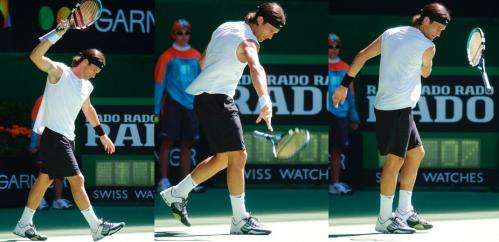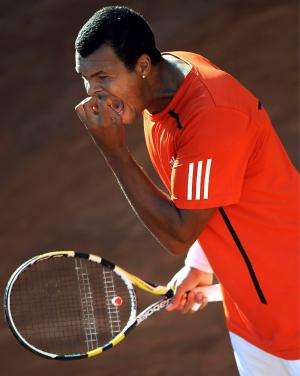Why some players can't keep their cool when the tennis heats up

Over the next two weeks, Melbourne Park will host the world's best tennis players for the Australian Open. We expect the best to perform under the watchful gaze of millions of fans around the world, so why do some athletes take pressure in their stride while others seem to blow their top?
It's a tricky question to answer, and could have biological and social reasons.
An area of particular interest to researchers is how players cope with stressful situations, or stressors, they encounter during matches, during training and outside of the tennis environment.
Stress is an inevitable aspect of competing at the highest level in any sport, but it is the way an athlete copes with these stressors which is likely to determine success.
Research clearly shows that the inability to cope effectively with challenges results in performance decrements, reduced satisfaction, increase in the probability of physical injury, burnout and even sport withdrawal.
Appraisal is key
The process by which tennis players deal with stressors they encounter, as well as the associated unpleasant feelings, is called coping.
American psychologists Richard Lazarus and Susan Folkman viewed stress and coping as a dynamic and recursive process – that is, a tennis player will appraise a particular situation in terms of
- if it endangers their goals and values
- the potential to deal with the situation.
This transactional approach suggests that coping might change in response to its effects on the situation. Coping outcomes in turn influence further appraisal, the person and environment.
A number of factors influence the stress and coping process. Our research at the Institute of Sport, Exercise and Active Living (ISEAL) focuses on how an athlete's personality (such as mental toughness) and gender influences coping in the sporting arena.
From general psychology we know male and female athletes cope differently with the same stressors, perhaps because females have a tendency to appraise a stressful event as more severe than males.
Higher stress intensity has been associated with the use of more – and different – coping strategies.
This makes sense – trying to cope with stress when in a high state of emotional arousal is generally not very productive. If you experience higher levels of stress it is beneficial to first lower those levels before carrying out coping strategies to solve the problem at hand.
On the tennis court, if a player keeps hitting their first service into the net it would be beneficial to analyse (as objectively as possible) what is going wrong without emotions getting in the way. This will allow the player to identify the issue (such as a poor ball toss) and rectify it.
Why gender differences?
Gender differences have been observed in emotional expression, social support seeking and socialisation. Females, for example, are more sensitive to external cues (such as other people's behaviour). Two theories explain why male and female athletes might cope differently:
- Social (learned) reasons: the so-called situational theory suggests that differences in coping are the result of the roles men and women occupy in society and/or the different stressors they encounter because of these roles.
- Biological (innate) reasons: an example is females release more of the hormone oxytocin during times of stress. Oxytocin is associated with the down-regulation of the sympathetic nervous system (which maintains homoeostasis and stimulating activities like the fight-or-flight response) and facilitates the parasympathetic nervous system (activities related to feed-or-breed or rest-and-repose). Higher levels of oxytocin result in a pattern of tend-and-befriend rather than fight-or-flight.

Practical applications
In our work we have tried to examine the two different theories using a golf putting task and using questionnaires with male and female soccer players.
We found that differences between male and female athletes are most likely due to the fact that they appraise similar stressful encounters in a different way, which results in different coping strategies.
From a practical perspective, coaches and sport psychologists should take into consideration the different way male and female athletes might appraise a stressful event. This will ultimately influence the coping repertoire required to deal effectively with stress and perform optimally.

When watching the tennis over the next fortnight you might want to observe the way the male and female players deal with the stressors they encounter (such as bad referee decisions and making technical or tactical mistakes).
The fact that there are few female John McEnroes might be due, mostly, to the gender differences in coping with stress. I predict you see more male players being verbally abusive than their female counterparts.
Maybe somebody can tally these and get a nice paper out of it!
This story is published courtesy of The Conversation (under Creative Commons-Attribution/No derivatives).
![]()
















